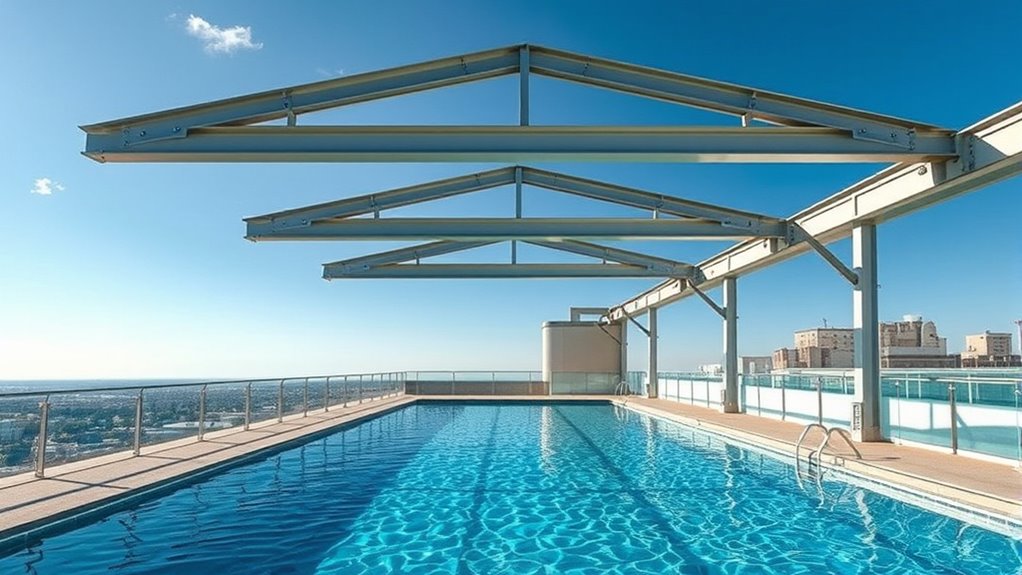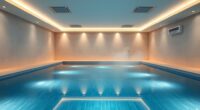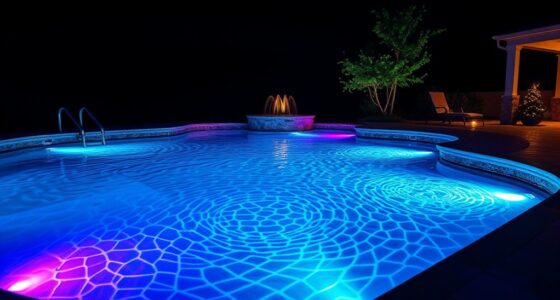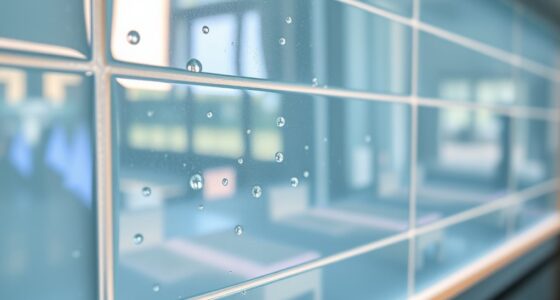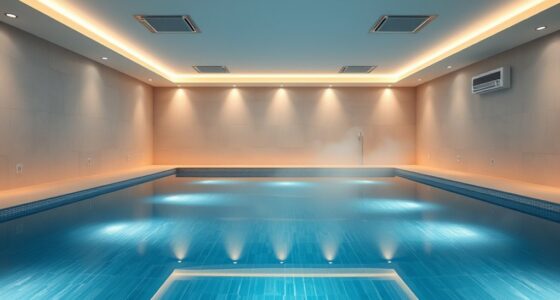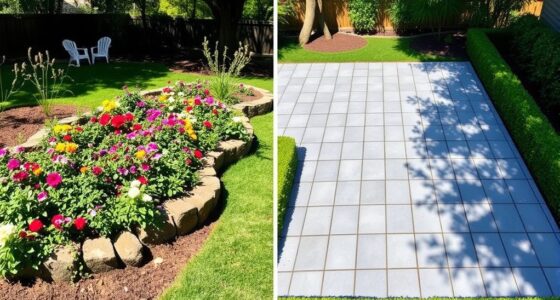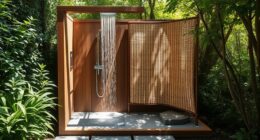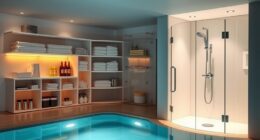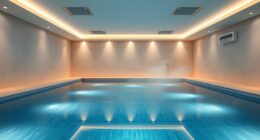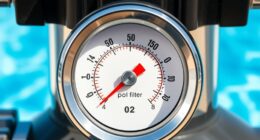When planning a rooftop pool, it’s important to select durable, weather-resistant materials like reinforced concrete or stainless steel to support the weight and withstand environmental forces. Proper waterproofing, using membranes or coatings, prevents leaks and protects the structure. Wind loads are managed by reinforcement, strategic placement, and anchoring systems to ensure stability. Effective drainage and water level control further enhance safety and durability. Keep exploring to discover how all these elements come together for a safe, long-lasting rooftop pool.
Key Takeaways
- Ensure the rooftop structure can support the pool’s weight, considering reinforcement and proper load distribution.
- Use durable waterproof membranes and coatings to prevent leaks and protect the building from water damage.
- Incorporate drainage systems and water level controls to manage rain, overflow, and evaporation effectively.
- Reinforce the pool’s edges and foundation to withstand wind, seismic forces, and environmental stresses.
- Design with safety features and materials resistant to weather and corrosion for long-term stability and longevity.
Understanding the Foundations of Rooftop Pools
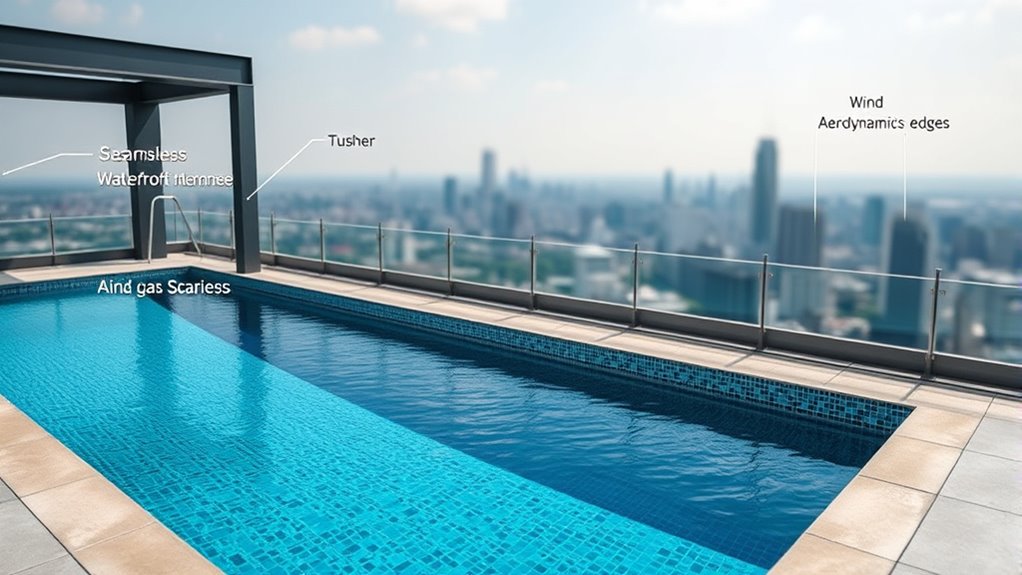
Rooftop pools require careful planning and engineering to guarantee they are safe and functional. Your first step is understanding the importance of a solid foundation. The weight of the water, along with the structure itself, puts significant stress on the building’s roof. You need to evaluate the existing structure’s load capacity and reinforce it if necessary. Proper waterproofing and drainage are critical to prevent water leaks that could weaken the building. You also have to take into account seismic and wind loads, which influence the foundation design. A well-designed foundation distributes the weight evenly, preventing structural damage. It is also essential to consider building codes and regulations that may impact the design and construction of rooftop pools. Working with structural engineers ensures that the foundation can support the pool’s weight over time, maintaining safety and stability for everyone below.
Choosing the Right Structural Materials for Durability
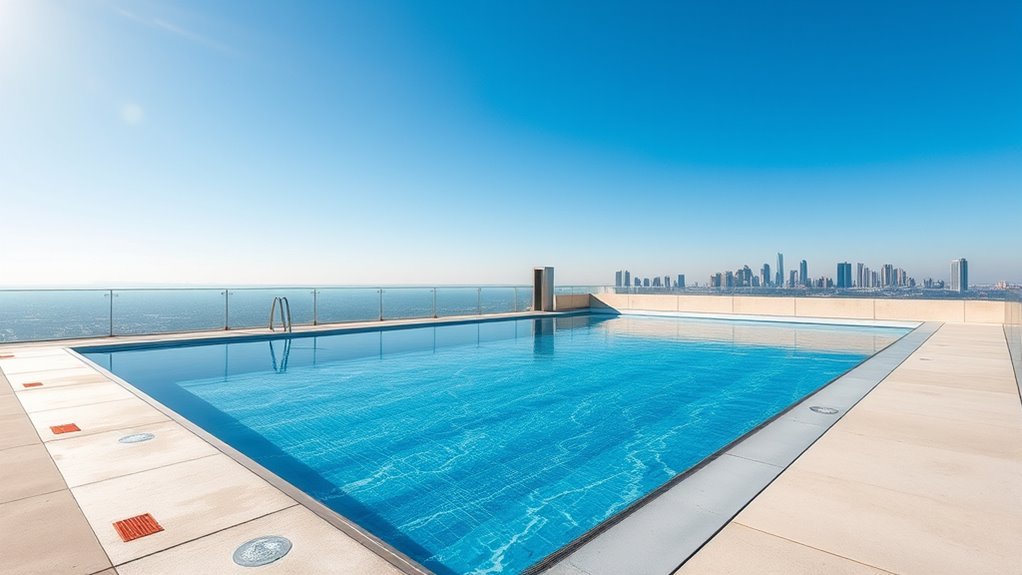
When selecting materials for your rooftop pool, you need to consider their strength and flexibility to handle weight and movement. It’s also essential to choose options with corrosion resistance features to withstand weather exposure. Balancing cost and installation time will ensure your project stays on budget and schedule without sacrificing durability. Additionally, choosing materials that complement the Bedroom aesthetic can enhance the overall visual harmony of your outdoor space.
Material Strength and Flexibility
Choosing the right structural materials is essential because they determine the rooftop pool’s ability to withstand weight, weather, and daily wear. You need materials with high strength to support the weight of water, equipment, and occupants without cracking or buckling. Flexibility is equally important, allowing materials to absorb movement from thermal expansion, wind, or settling without damage. You should select materials that combine durability with resilience, like reinforced concrete or steel, which offer both strength and flexibility. These materials prevent cracking under stress and adapt to structural shifts. Properly balancing strength and flexibility ensures your rooftop pool remains safe, functional, and long-lasting despite the challenges posed by environmental forces and usage demands. Additionally, understanding the material properties is crucial for selecting the most suitable options for your specific climate and structural requirements.
Corrosion Resistance Features
Selecting materials with strong corrosion resistance is essential for guaranteeing your rooftop pool’s longevity. Since exposure to water, humidity, and outdoor elements accelerates deterioration, choosing the right materials protects your investment. Stainless steel, especially grade 316, offers excellent corrosion resistance and structural strength. Fiber-reinforced polymers (FRP) are lightweight, durable, and resistant to rust and chemicals. Concrete mixes with corrosion inhibitors help prevent rebar deterioration, extending the lifespan of your structure. Coatings like epoxy or polyurethane provide an extra layer of protection against moisture and corrosive agents. When selecting materials, prioritize those specifically designed for outdoor and aquatic environments. Doing so minimizes maintenance costs, prevents leaks, and guarantees your rooftop pool remains safe, functional, and attractive for years to come. Additionally, understanding AI security measures can enhance monitoring and maintenance systems, ensuring your pool’s safety and durability over time.
Cost and Installation Time
Considering your budget and timeline is essential when deciding on structural materials for your rooftop pool. Some materials, like shotcrete or gunite, offer durability but can be costly and require longer installation times due to specialized labor. Concrete slabs are more affordable and quicker to install but may need additional waterproofing and reinforcement. Structural steel provides strength and faster assembly but adds to upfront costs. Lightweight materials, such as foam cored panels, reduce installation time and weight but might be less durable long-term. Your choice depends on balancing initial costs, project deadlines, and long-term maintenance. Planning ahead helps you select materials that fit your budget while ensuring the pool’s longevity and stability without unnecessary delays. Utilizing appropriate storage solutions can also streamline construction materials and equipment organization on-site, reducing clutter and improving efficiency during installation.
The Role of Reinforcement in Pool Construction

Reinforcement materials are essential for ensuring your pool’s stability and durability. Choosing the right type, like steel or fiber-reinforced composites, can markedly boost its structural integrity. Understanding how these reinforcements work helps you build a safer, long-lasting rooftop pool. Incorporating appropriate exfoliation techniques can further enhance the longevity of the pool’s surface by preventing surface degradation over time.
Reinforcement Material Types
The success of a rooftop pool heavily depends on the reinforcement materials used during construction, as they provide the necessary strength and durability to withstand water pressure and environmental stresses. Choosing the right reinforcement material is vital. Here are key options:
- Steel Rebars: Most common, offering high tensile strength and flexibility.
- Fiberglass Reinforcements: Lightweight, corrosion-resistant, ideal for complex shapes.
- Fiber-Reinforced Polymers (FRP): Strong, lightweight, and resistant to chemicals and corrosion.
- Mesh Reinforcements: Used in conjunction with other materials to improve crack resistance and distribute stresses evenly.
Selecting the appropriate reinforcement depends on your pool’s design, location, and environmental factors, ensuring longevity and safety.
Structural Integrity Enhancement
To guarantee your rooftop pool remains safe and durable over time, strengthening its structural framework is essential. Reinforcement plays a key role in preventing cracks, shifting, and failure under load, especially with the added weight of water and environmental forces. You should incorporate steel rebar or mesh within the concrete to enhance tensile strength, ensuring the structure can handle dynamic forces like wind and temperature changes. Proper reinforcement placement also helps distribute stresses evenly, reducing risk points. Regular inspections and adjustments during construction ensure that reinforcement remains correctly positioned and intact. Additionally, understanding the importance of production quantity variance can help in planning and managing construction projects more effectively, minimizing delays and cost overruns. By prioritizing reinforcement, you create a resilient foundation that safeguards against structural issues, prolongs the lifespan of your rooftop pool, and maintains safety for all users.
Waterproofing Techniques for Rooftop Environments

Ensuring a reliable waterproofing system is essential when designing rooftop pools, as these structures are constantly exposed to the elements and water pressure. You need effective techniques to prevent leaks and damage. Consider these key methods:
- Liquid-applied membranes: Seamless coatings that form a flexible, waterproof layer.
- Sheet membranes: Prefabricated sheets made from PVC, TPO, or EPDM, carefully installed for durability.
- Crystalline waterproofing: Chemical treatments that penetrate and strengthen concrete against water ingress.
- Protective layer coatings: Sealants applied over membranes to shield against UV rays and physical damage.
Choosing the right approach depends on your pool’s design, location, and expected water load, ensuring long-term waterproof performance. Proper waterproofing is crucial for maintaining the integrity of rooftop pools, especially in environments subject to wind loads and other external forces.
Managing Water Pressure and Pool Drainage
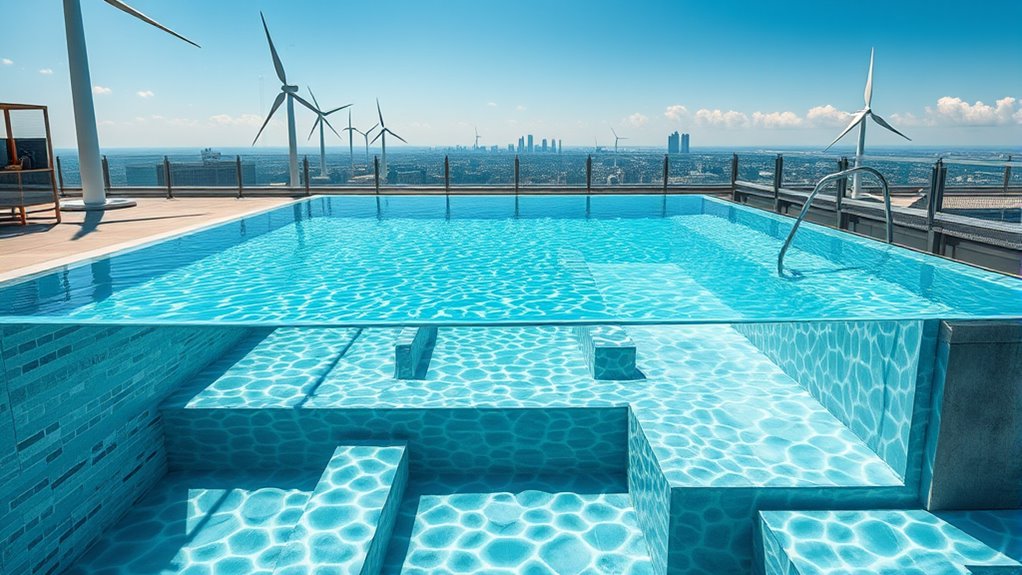
Managing water pressure and drainage is vital for your rooftop pool’s safety and longevity. You need to control the water level carefully and design an effective drainage system to prevent overflow or structural stress. Paying attention to these points ensures your pool stays functional and secure over time. Incorporating automation’s role in business intelligence can help monitor water levels and detect potential issues in real-time, further safeguarding your investment.
Water Level Control
Have you ever wondered how rooftop pools maintain a stable water level despite fluctuations? It all comes down to effective water level control. You’ll want to focus on:
- Automatic water level sensors that detect changes and trigger adjustments.
- Overflow outlets that prevent excess water from spilling over.
- Overflow drainage systems that channel excess water safely away.
- Controlled inlet valves that regulate water input based on real-time levels.
- Proper water pressure management ensures the structural integrity of the pool and prevents damage caused by pressure imbalances. These components work together to keep the water pressure balanced and prevent structural stress. Proper water level management ensures your rooftop pool remains safe, functional, and visually appealing, even as weather conditions or usage patterns change. Quick adjustments and reliable monitoring keep everything running smoothly.
Drainage System Design
Effective drainage system design is essential for maintaining the integrity of your rooftop pool, especially when it comes to controlling water pressure. Proper drainage prevents water buildup that can stress the structure or cause leaks. You should incorporate a well-planned network of drains, outlets, and slopes to direct water efficiently. Consider factors like rainfall, evaporation, and usage when designing your system. To make it clearer, here’s a quick comparison:
| Drain Type | Purpose |
|---|---|
| Perimeter Drains | Collect runoff from pool edges |
| Floor Drains | Remove water pooling on the pool floor |
| Overflow Drains | Prevent water from spilling over the edge |
| Ventilation Drains | Relieve air pressure in the system |
| Pump Out Drains | Empty excess water quickly |
A reliable drainage system keeps your pool safe, functional, and long-lasting.
How Wind Loads Affect Rooftop Pool Design
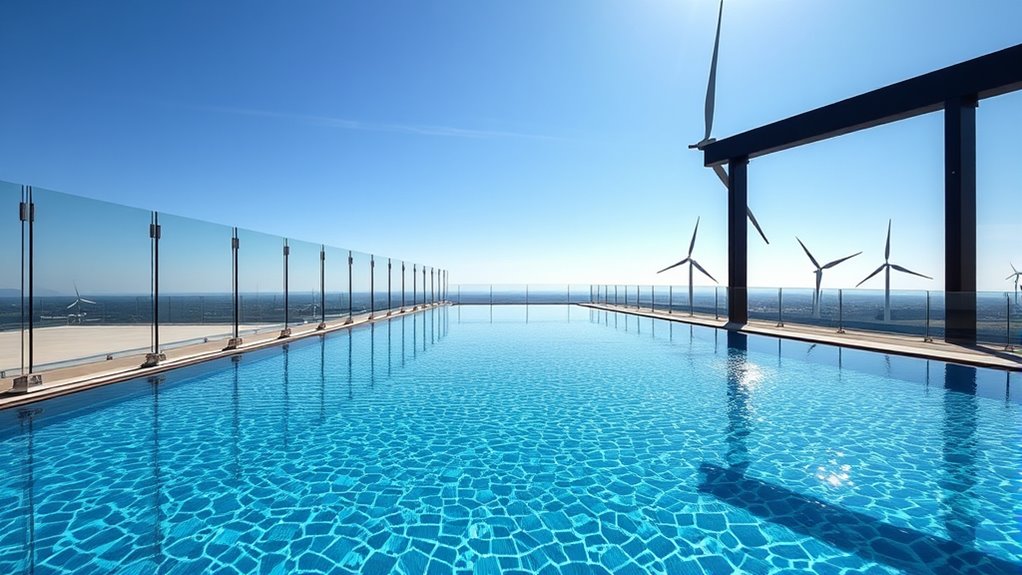
Wind loads play a critical role in shaping the design of rooftop pools, especially in tall buildings exposed to strong gusts. These forces impact your pool’s structural integrity and safety. To manage wind effects effectively, consider:
- Structural reinforcement to resist lateral forces
- Aerodynamic pool enclosures that reduce wind pressure
- Proper anchoring systems to prevent movement or uplift
- Strategic placement away from high-wind zones
Ignoring wind loads can lead to structural damage, water spillage, or even pool detachment. You need to account for wind pressure during design, ensuring your rooftop pool remains stable under gusty conditions. Proper planning minimizes risks, enhances safety, and prolongs the lifespan of your luxury feature.
Designing for Safety and Stability
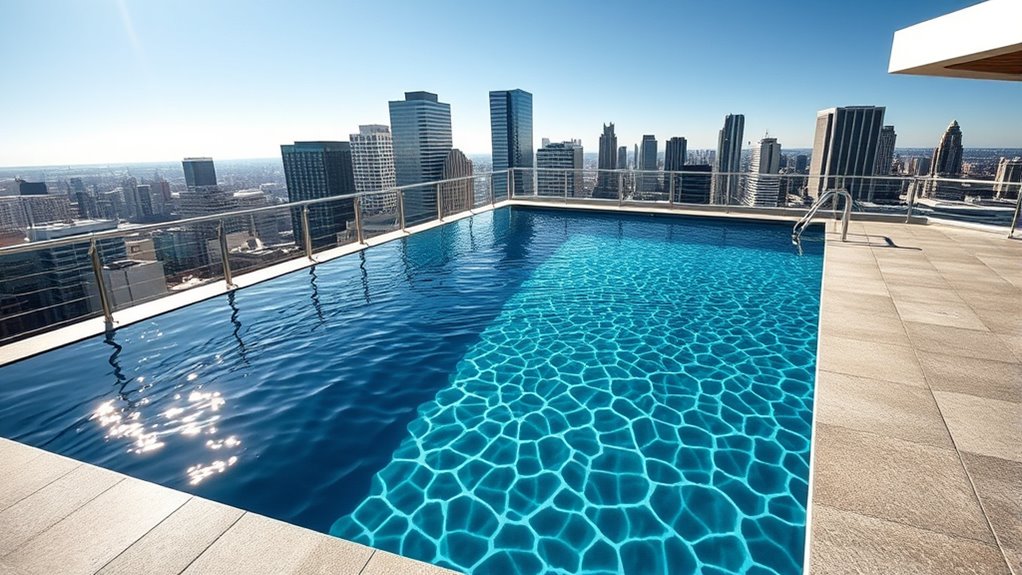
To guarantee your rooftop pool remains safe and stable, careful attention to design details is essential. You must ensure the structure can withstand loads from the water, occupants, and environmental forces. Use strong, durable materials that resist corrosion and structural fatigue. Reinforce the edges and corners to prevent cracking or failure under stress. Incorporate safety features like sturdy railings, non-slip surfaces, and secure access points. Balance the pool’s weight distribution to avoid uneven stress on the building’s framework. Regular inspections and maintenance are critical to identify potential issues early. By prioritizing these design elements, you create a safe environment that maintains stability over time, even under challenging conditions like high winds or shifting loads.
The Importance of Proper Drainage and Waterproof Barriers
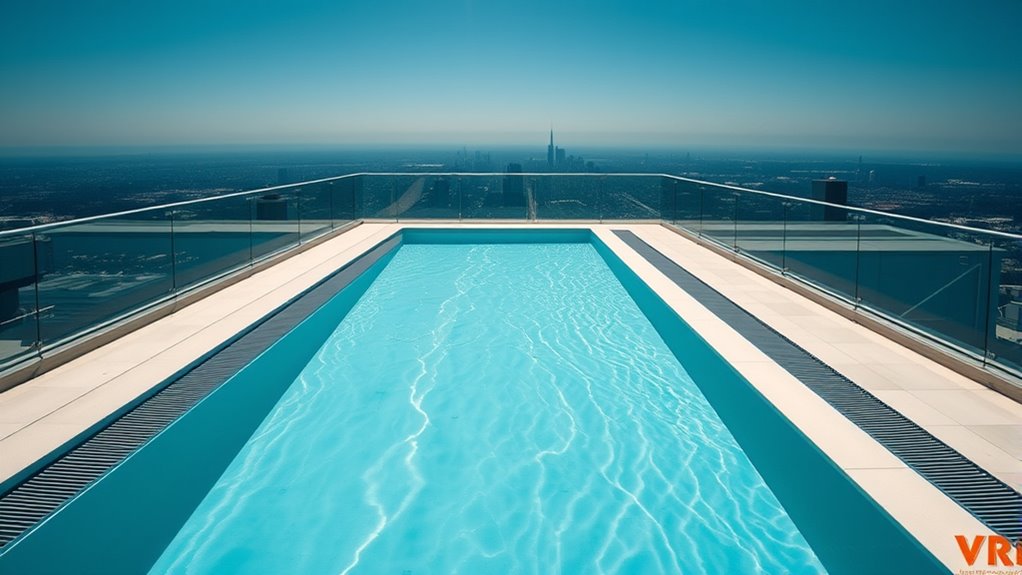
Ensuring your rooftop pool remains safe and stable isn’t just about strong materials and sturdy design; it also depends on proper drainage and waterproof barriers. Without effective drainage, water can pool, causing added weight and potential structural damage. Waterproof barriers prevent leaks that could compromise your building’s integrity or damage interior spaces. To achieve this, consider these critical elements:
- Proper slope: Ensures water flows toward drains efficiently.
- High-quality membranes: Prevent water penetration and resist UV damage.
- Adequate drainage systems: Handle heavy rain and overflow without pooling.
- Seamless waterproofing: Eliminates weak points where leaks could occur.
Focusing on these aspects guarantees your rooftop pool remains safe, functional, and long-lasting.
Maintenance Tips to Extend the Life of Your Rooftop Pool
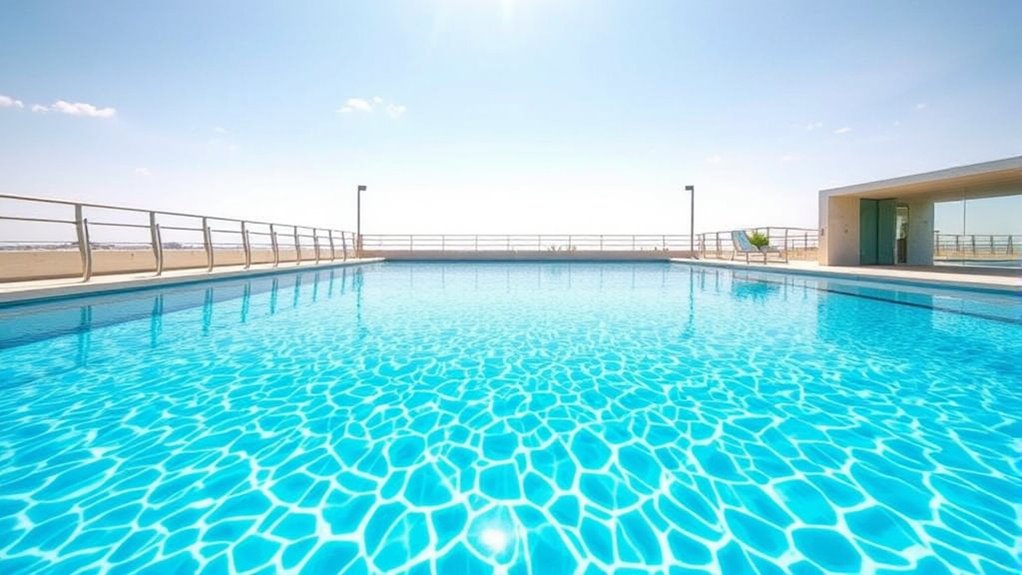
Regular maintenance is essential to keep your rooftop pool in ideal condition and extend its lifespan. Regularly check water levels, clean filters, and remove debris to prevent buildup that can damage the structure. Test water chemistry weekly to avoid corrosion or algae growth, adjusting chemicals as needed. Inspect the waterproof barrier for cracks or leaks and repair promptly. Keep an eye on the pump and filtration system to ensure efficient operation.
| Maintenance Task | Frequency |
|---|---|
| Water level check | Weekly |
| Filter cleaning | Bi-weekly |
| Waterproof barrier inspection | Monthly |
| Chemical balancing | Weekly |
Innovations and Trends in Rooftop Pool Construction
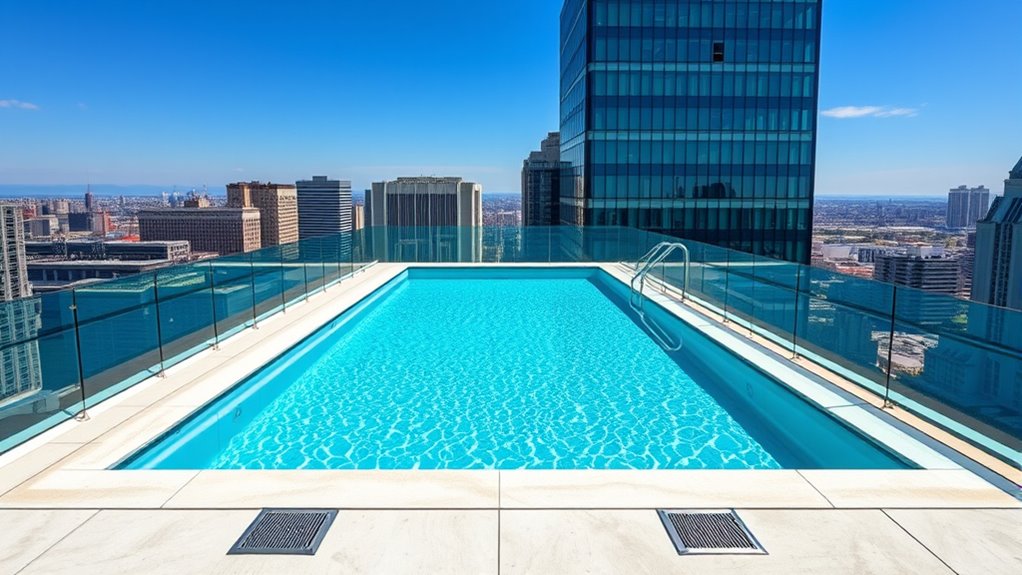
Innovations in rooftop pool construction are transforming how urban spaces incorporate luxury and functionality. New materials and design techniques are making pools more durable, eco-friendly, and stylish. Here are four key trends to watch:
- Modular Pool Systems – prefabricated, customizable pools that simplify installation and maintenance.
- Smart Technology Integration – automation for temperature, lighting, and cleaning, enhancing user experience.
- Lightweight Materials – use of advanced composites reduces structural load, enabling larger pools on smaller rooftops.
- Eco-Conscious Designs – solar heating, rainwater harvesting, and energy-efficient pumps lower environmental impact.
These innovations allow you to enjoy luxurious rooftop pools while addressing structural, waterproofing, and sustainability concerns more effectively.
Frequently Asked Questions
How Do Rooftop Pools Impact Building Structural Integrity?
Rooftop pools can impact your building’s structural integrity by adding significant weight, which requires reinforced support systems. You’ll need to make certain the structure can handle the extra load of water, people, and equipment. Proper waterproofing and wind load considerations are essential to prevent leaks and structural damage. If you don’t plan carefully, the added stress could compromise the building’s stability over time, leading to costly repairs.
What Are the Cost Considerations for Rooftop Pool Construction?
Building a rooftop pool costs a fortune—think thousands of dollars just for the waterproofing alone! You’ll need reinforced structures, top-tier waterproof membranes, and wind-resistant designs, all adding up fast. Don’t forget permits, professional labor, and ongoing maintenance. These expenses can skyrocket, making a rooftop pool a luxury that’s hard to justify for most. Be prepared for a hefty financial commitment that could rival the price of your entire building!
How Can Rooftop Pools Be Designed for Energy Efficiency?
To make your rooftop pool energy-efficient, you should install a high-quality, energy-efficient filtration and heating system. Consider adding solar panels to harness renewable energy, reducing operating costs. Use LED lighting and insulated pool covers to minimize heat loss. Properly design and orient the pool to maximize natural sunlight during the day, and incorporate smart controls to optimize energy use. These steps help you save energy and reduce long-term expenses.
Are There Specific Building Codes for Rooftop Pools?
Yes, there are specific building codes for rooftop pools that you need to follow. These codes address structural integrity, waterproofing, wind loads, and safety standards. You should check local regulations and building codes to guarantee compliance. It’s essential to work with professionals who are familiar with these regulations so your rooftop pool is safe, legal, and durable. Ignoring these codes can lead to fines, safety hazards, or costly modifications later.
What Safety Measures Are Recommended for Rooftop Pool Users?
Did you know that falls are the leading cause of injury in rooftop pools? To stay safe, always supervise children closely and guarantee the pool has secure fencing and non-slip surfaces. Use safety equipment like life rings and maintain clear access paths. Regularly inspect the pool’s barriers and drain covers, and don’t forget to follow local safety regulations. Your vigilance keeps everyone safe and makes rooftop pool enjoyment worry-free.
Conclusion
Building a rooftop pool is like crafting a sturdy ship on a skyscraper’s deck—you need solid foundations, waterproof armor, and careful planning to weather every breeze and wave. By understanding the key elements of structure, waterproofing, and wind loads, you’ll guarantee your oasis stays afloat and beautiful for years. With the right knowledge, your rooftop pool becomes a resilient paradise amidst the bustling skyline, ready to withstand whatever the wind blows your way.
